�

�
Dudley Cunningham's 1959 Lotus 15 Series 3 Racecar
� ��
Owner: Dudley Cunningham
�
City: Carlisle, Massachusetts
�
Model: 1959 Lotus 15 Series 3
�
Engine: Climax FPF 2L four cylinder
�
Prepared by: KTR Racing�
�
A Lotus Sports Racer for Larger Displacement Racing Classes
��
Colin Chapman looked to build on the tremendous success of his�
Lotus Eleven model by developing�
a similar chassis, except suitably upgraded to accommodate larger displacement and therefore more powerful�
engines. The Lotus 15 wasn't intended as a replacement for the Eleven; instead, it widened Lotus' product�
range to cover additional racing classes.�
�
The availability of Coventry Climax's FPF engine series in new and larger displacements was one of the�
catalysts which propelled the Lotus 15 project. The FPF engine had been conceived for Formula Two, and�
its production started in late 1956 with a 1.5L (1475cc) version. Soon thereafter, 2.0L (1960cc and�
2015cc,) and 2.2L (2205cc) versions arrived. In late 1958 a substantially uprated 2.5L (2495cc)�
version was announced. Variants of the FPF were competitive in Formula One racing from 1959 through 1961.�
�
In combination with the FPF engine, Lotus also designed the 15 around their own distinctive "Queer Box"�
transaxle. This was a sequential-shift five speed gearbox and a ZF limited slip differential in a common�
magnesium housing with a dry sump lubrication system of its own. Like a motorcycle transmission, constant�
mesh gears and a simple fore-and-aft gearchange mechanism promised very quick gear changes. On the plus�
side, the design was extremely light and compact. The whole system: gearbox and differential assembly,�
inboard disc brakes, and halfshafts totaled up to just 85 pounds - all of them behind the driver!�
The downside was that the gearbox gave many drivers problems; it developed a reputation as "a gearbox�
full of neutrals."�
�
On first impression, the Lotus 15 looked quite a bit like an Eleven, but a larger radiator opening and�
a distinctive new low-height, full-width windscreen are two styling cues that set the new model apart�
from the beginning. Series 2 and 3 examples of the model feature a distinctive bonnet scoop. All Lotus�
15s featured all-aluminum bodies by Williams & Pritchard Ltd. Underneath, 15s featured a new but�
familiar looking spaceframe chassis. The 15 was the first Lotus sports racer to feature four wheel�
independent suspension, but few of the components were really new: the front suspension mostly carried�
over from the Lotus Eleven Series 2, and the Chapman Strut rear suspension largely carried over from�
the Lotus 12 Formula Two racecar. �
�
Lotus had worked hard to minimize the frontal area of the Lotus 15 model although some contemporary�
magazine reports wildly exaggerated success in that regard. The two models used similarly sized tires�
spaced apart the exact same distance and covered by similarly profiled fenders. To achieve a low bonnet�
and scuttle height, Lotus did initially set the Fifteen's Cosworth FPF engine over at a radical angle -�
~28° from vertical! - but that quickly proved to be a mistake. After building a half dozen cars,�
Lotus reverted to an engine installation angle of about seventeen degrees in time for the 1958 24 Hours�
of Le Mans race. (Coventry Climax engines in Lotus Eleven racecars were leaned over ten degrees from�
vertical.) Lotus initially angled the FPF engine about 7.5 degrees away from chassis centerline in�
plan view, to make extra room for the driver seat.�
�
To get the driver as low as possible, the Lotus 15 came with only about a quarter inch of padding in�
the seat and the backrest was laid-back far enough for some drivers to complain. A carefully contoured�
wrap-around windscreen was designed to meet the letter of Appendix C rules, while causing minimal air�
disturbance. Early magazine reports lauded a remarkably low scuttle height of just 24 inches, but perhaps�
a more important measure of limbo-winning success what that windscreen height relative to the floorboard�
was 1.25" lower than on the Eleven.�
�
�

�
Dudley Cunningham's Lotus 15 shares victory lane with Glenn Stephens' Lotus Eleven.
�
Production Was Divided Between Three Series Classifications
��
The Lotus 15 model debuted at Goodwood on 7 April 1958, with Team Lotus driver Graham Hill setting a�
new lap record before dropping out due to gearbox problems. Queer Box problems seemed to be the�
model's Achilles heel, so Lotus quickly developed an alternative specification. The Lotus 15 Series 2�
featured a BMC B-series four-speed transmission in lieu of the Queer Box.�
Nine Series 1 cars were built by July 1958 when the Series 2 became available, and eight Series 2�
cars were built between July and the end of the year.�
�
A Lotus 15 Series 3 variant was developed for 1959. It featured a somewhat beefed up frame, a�
differently configured front suspension, and updated bodywork. The Series 3 could be purchased with�
either a Queer Box five speed (now recommended for 1.5L engines only) or a BMC four speed (recommended�
for larger displacement cars and export markets.) Other gearboxes were possible too, either on a�
special-order basis or as an after-the-fact upgrade. At least one customer is known to have�
special-ordered a ZF five-speed. It's estimated that seven Series 3 cars were built during 1959.�
Production of the Lotus 15 ceased at the end of 1959.�
�
Total production of the Lotus 15 model has been reported as 28 cars. That's the number you get by�
simply comparing the first and last serial numbers assigned. However, serial numbers were assigned�
to replacement frames and to car kits. The Lotus 15 was available fully assembled (at an advertised�
base price of £2885), or as a kit (advertised from £2395). Sometimes kits were used to�
repair damaged racecars. �
�
Lotus 15 racecars won some significant races, but they were unlucky at the very highest level of�
competition. �
At the 1958 24 Hours of Le Mans race, Cliff Allison and Graham Hill were forced to retire after just�
three laps due to a head gasket problem with their 2.0L FPF. American drivers Jay Chamberlain and Pete�
Lovely were entered in the 1.5L class, but Chamberlain wrecked on the 40th lap (of 305). Lotus brought�
a 2495cc powered 15 to Le Mans in 1959. Co-drivers Graham Hill and Derek Jolly both complained of�
gearbox problems. Ultimately, Derek Jolly missed a shift and over-revved the engine�
on the 120th lap (of 323). �
�
In retrospect, the Lotus 15 is certainly one of the last important racecars of the front-engine�
era. Its career in professional international racing was curtailed because the mid-engined Cooper�
Monaco came along. After that, front-engined sports racers like the Lotus 15 were obsolete.�
Lotus turned its attention to developing its own mid-engined sports racer, the type 19 (a.k.a.�
"Monte Carlo") of 1960.�
�
�
 �
�
�
�
�
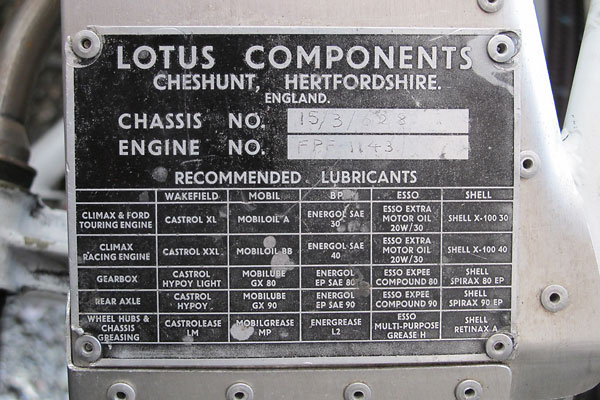
�
LOTUS COMPONENTS - Cheshunt, Hertfordshire. - England.
�
Chassis No.: 15/3/628 - Engine No.: FPF 1143
�
Dudley Cunningham's Lotus Fifteen (chassis number 15/3/628)
��
Lotus serial number "15/3/628" is believed to be the final Lotus 15 racecar built. (22 are�
known to survive, and at least five of them are vintage raced in North America.) This car�
was originally owned by John Posselius who retained a driver named John Charles "JC" Kilburn�
to race it in the central U.S. and at Nassau in the Bahamas.�
�
During the 1959 Nassau Speed Week, on 4 December 1959, Kilburn's gearbox blew up and he failed to�
complete the 54 mile Governor's Trophy race. �
Posselius and Kilburn arranged to have a Borg-Warner T10 four-speed gearbox installed and it�
has remained in the car ever since!�
�
During the 1960 Nassau Speed Week, on 4 December 1960, Kilburn wrecked in practice for�
the 242 mile Nassau Trophy race. �
�
�
Posselius sold the Lotus to Ralph Darlington in 1961. Darlington chose Bill Wadell as his driver.�
Sometime in this period, Lotus 15 number 628 was repaired and fitted with a Buick 215 dry sump motor.�
With that motor installed, Wadell won the C-Modified race at Grayling Michigan on September 17, 1961.�
The team traveled to the Bahamas for 1961's Nassau Speed Week, where Wadell wrecked during practice�
for the Preliminary Governor's Trophy race (S+2.0). The car flipped over and burst into�
flames. Extensive repairs were necessary.�
�
There were several more owners. By the late sixties, Lotus 15 number 628 had been registered�
for street use, and we understand it appeared at many car shows in the Upper Midwest region.�
Bob Tamsen owned chassis 628 from 1975 until 1993, and he freshened it up while retaining the�
Buick engine.�
�
Herb Wetanson acquired Lotus 15 number 628 in 1993 and arranged to have KTR Racing restore it.�
Wetanson purchased a 2 liter Climax FPF from Crosthwaite & Gardiner to replace the Buick 215,�
and he had KTR Racing substantially alter the chassis in a failed attempt to get number 628 to�
handle. Ultimately though, the car didn't seem to be a good fit for Herb's needs, so he decided�
to sell it and purchase a Cooper Monaco.�
�
Early in 2006, fellow KTR Racing customer Dudley Cunningham leapt at the opportunity to�
purchase number 628. He wanted to restore it as correctly as possible, and to this end he worked�
closely with Lotus 15 registrar and guru Bill Colson. Colson provided copies of original�
drawings without which KTR would have been lost, and he even came over from England to�
supervise key aspects of the restoration.�
�
When Dudley Cunningham arranged to purchase number 628, he had already been racing a Lotus Eleven�
Series 2 for nearly 30 years. He initially found the 15 to be much less sure-footed, but it wasn't�
clear what specific changes were needed. Lap times were slower in the 15 despite a substantial power�
advantage. However, KTR's John Brundage has now figured out how to set up the car so it handles�
better than ever. Now it's much more toss-able and it does a far better job of delivering power�
out of corners. Dudley Cunningham has picked up ten seconds per lap at Watkins Glen in just the�
last year or so! Now that Cunningham knows what the car can do, he doesn't expect he'll ever let it go.�
�
�
�
Please support the sponsoring companies who make www.BritishRaceCar.com possible, including:
� �
 �
�
�
�
Features and Specifications
�| Engine: | �Coventry Climax FPF (DOHC) 2.0L four cylinder engine.�
Dual Weber 48DCO 2S/P carburetors.�
Custom fabricated aluminum intake manifolds.�
K&N pleated oiled-gauze air filters.�
Lucas distributor.�
Lumenition breakerless ignition module.�
Lucas AB14 (part# DAC4104) electronic ignition amplifier.�
�
Lucas Sport ignition coil.�
Moroso Blue Max 8mm spark plug wires.�
Baldwin Filters B253 oil filter on a Mocal remote filter mount.�
| �
| Cooling: | �custom aluminum crossflow radiator, painted black. | �
| Exhaust: | �custom stainless steel tri-y headers. (Bung for O2 sensor on secondary collector.) | �
| Transmission: | �Borg Warner T10 4-speed.�
Hurst shifter.�
Girling 5/8" bore master cylinder. | �
| Rear End: | �BMC final drive housed in a custom housing.�
Limited slip differential | �
| Front Susp.: | �dual wishbone front suspension, although with anti-sway bar arms serving�
as the rearward legs of the upper control arms.�
KONI double-adjustable aluminum bodied coilover shock absorbers.�
Hyperco springs.�
Alford & Alder forged uprights.�
47" track. | �
| Rear Susp.: | �KONI double-adjustable steel bodied coilover shock absorbers, mounted in Chapman Strut fashion.�
Hyperco springs.�
(A single low-mounted trailing link in combination with the halfshaft completes wheel location.)�
48" track. 88" wheelbase. | �
| Brakes: | �(master) dual Girling (3/4" bore) master cylinders with adjustable bias bar. � (front) Girling AR 2" bore aluminum brake calipers with 9.5" solid rotors, mounted outboard. � (rear) Girling NR 1.5" bore aluminum brake calipers with solid rotors, mounted inboard. | �
| Wheels/Tires: | �Lotus magnesium wobbly-web 6-lug wheels.�
Dunlop Racing tires (5.00L-15 front & 5.50L-15 rear, CR65 MkII tread pattern, 204 compound.) | �
| Electrical: | �Enersys Genesis (Yuasa) NP33-12 sealed lead acid battery.�
Hitachi gear reduction starter, part number B114-264TP. | �
| Instruments: | �(left to right)�
Smiths oil temperature guage (40-140C),�
Smiths dual oil pressure (0-100psi) and water temperature (80-230F) gauge,�
Stack tachometer (0-8000rpm), and �
Smiths ampmeter (+/-30 amps). | �
| Fuel System: | �Facet (Bendix Style) electric fuel pump.�
Mr Gasket adjustable (1-6psi) fuel pressure regulator.�
19 Imperial gallon aluminum fuel tank, custom built to original Lotus engineering drawings. �
| �
| Safety Eqmt: | �Schroth Racing 6-point cam-lock safety harness.�
SPA Firesense AFFF (15 pound, 2 liter) centralized fire suppression system.�
SPA quick release steering hub, mounted on a RaceTech steering wheel.�
| �
| Weight: | �~980 pounds, dry.�
| �
Engine Installation
��
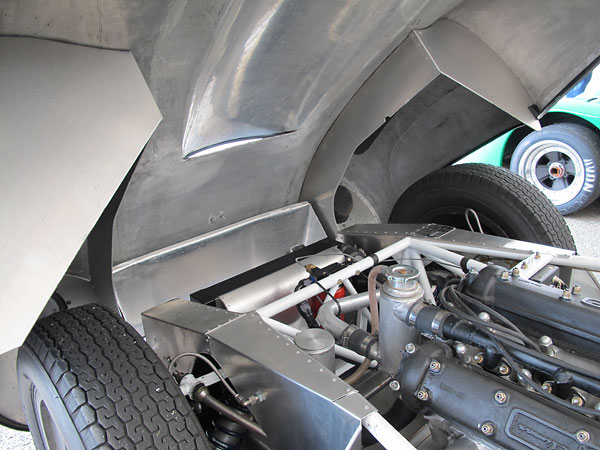
�
Coventry Climax FPF (DOHC) 2.0L four cylinder engine with dual Weber 48DCO 2S/P carburetors.
�
The engine features gear driven dual overhead camshafts, with valves installed at a 66° angle.
�
The aluminum engine block holds wet iron liners.
�
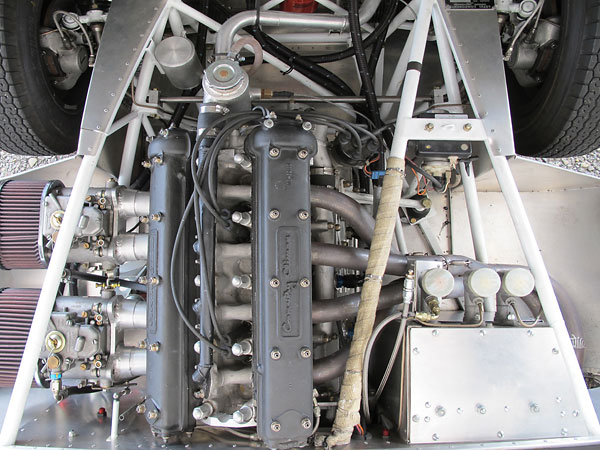
�
Although initially conceived for Formula Two, with development the FPF engine came to dominate 2.5L
�
Formula One. For the 1961 Formula One season, maximum engine displacement was restricted to
�
1.5L, so the FPF continued into the new era. Claimed output dropped from 239bhp to 151bhp.
�
With an FPF-powered Cooper, Jack Brabham won the 1959 and 1960 championships.
�
FPF-powered Lotus racecars won three Formula One championship races in 1961.
�
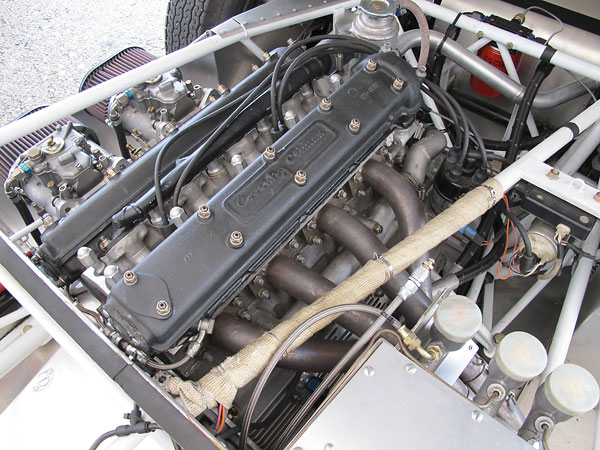
�
In this view you can just see the aluminum gearbox adapter plate to which a Borg Warner T10 4-speed
�
transmission is mounted. The T10 was installed in early 1960 after the original BMC 4-speed failed
�
at Nassau. Dudley would rather have a different transmission but this one seems to be plenty
�
durable and he's getting used to it. "It's about as good as you can make it." The Lotus 15
�
originally came with a hydraulic clutch, and this example still has one.
�
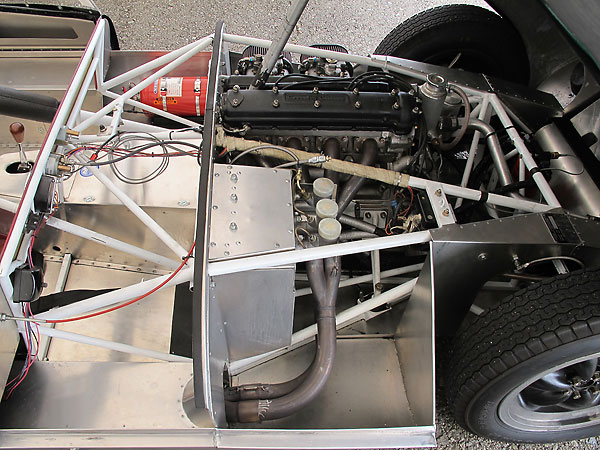
�
The Climax FPF engine is relatively lightweight for its output. In final 1961 Formula One
�
trim it weighed approximately 255 pounds, dry.
�

�
After 1961 the FPF engine was no longer competitive in Formula One. The technological trend
�
favored V8 engines, which revved faster without sacrificing reliability. At the height of its
�
development, the FPF was good to ~7500rpm. The Climax FWMV V8 which replaced it in
�
1962 was good to 8500rpm, and was uprated for 10,500rpm operation by the 1965 season.
�
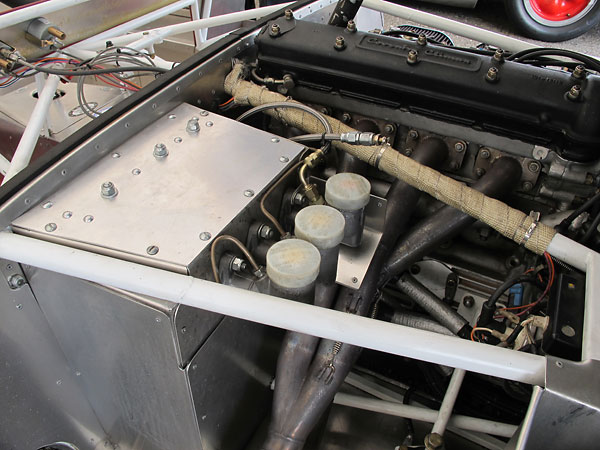
�
Dual Girling 3/4" brake master cylinders and Girling 5/8" clutch master, all with integral reservoirs.
�
Original Lotus 15s came with a single brake master cylinder, but they were the first Lotus racecars
�
to come standard with hydraulically operated clutchs.
�
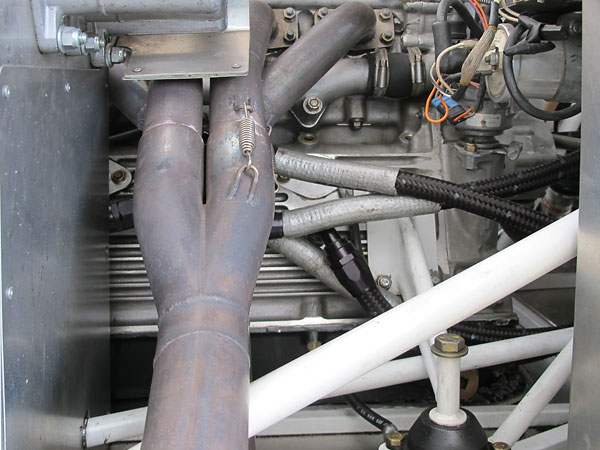
�
Custom stainless steel tri-y exhaust header, built by KTR Racing.
�
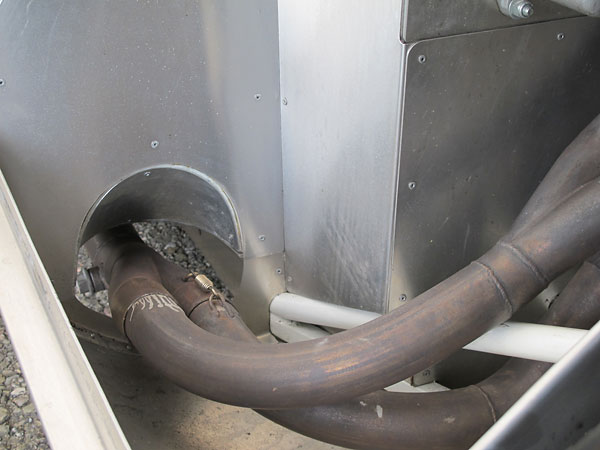
�
An oxygen sensor bung has been welded on, beyond the secondary exhaust collector. In combination
�
with an air/fuel ratio gauge or data acquisition system, a wideband oxygen sensor is an exceptionally
�
helpful tuning tool. Since they're conspicuously modern, vintage racers typically remove them for races.
�
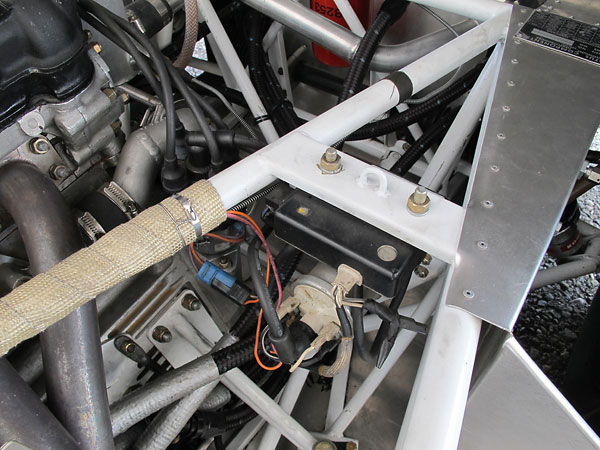
�
Lucas AB14 "constant energy ignition" box (part# DAC4104, '93 Jaguar XJS spec)
�
and Lucas Sport ignition coil.
�
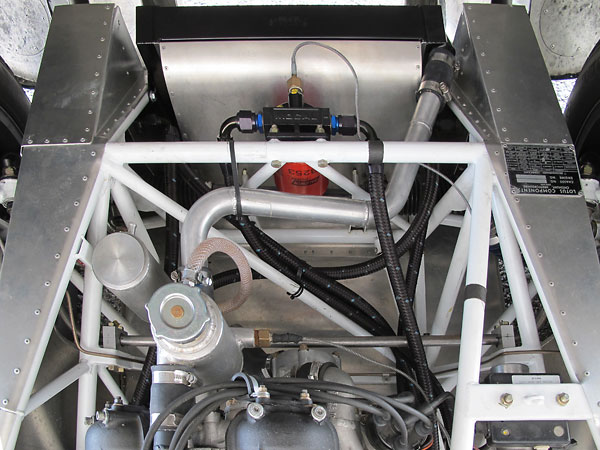
�
Baldwin Filters B253 oil filter on a Mocal remote filter mount.
�
�
IMPORTANT ANNOUNCEMENT
�
BritishRaceCar.com will have to cut back plans for continued growth if we can't find more financial support.
�
If you like what you've found here, and you want to see more, please click here and follow the instructions.
�
Readers like you keep BritishRaceCar.com online and growing through voluntary financial contributions.
�
�
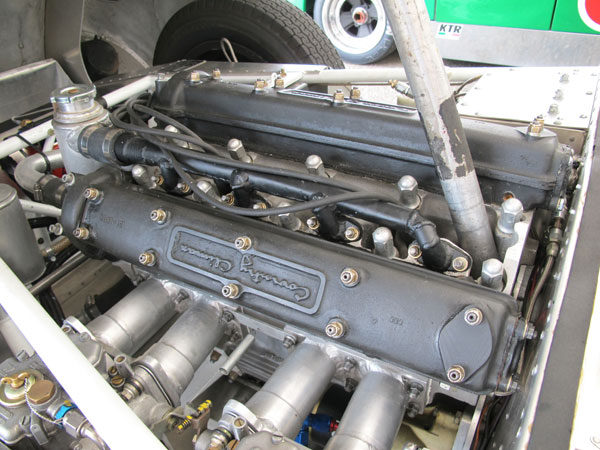
�
Coventry Climax had developed the FPF engine for Formula Two, and designed a dry sump lubrication
�
system for it from the beginning. Lotus redesigned much of the system (oil pan, pickups, pump, etc.)
�
plus other installation parts (e.g. intake manifolds) to lay the FPF engine over about ~28° from
�
vertical. Getting engine mass low in the chassis was a laudable goal, but it came at great expense in
�
terms of reliability. After building six cars, Lotus reverted to a seventeen degree installation angle.
�
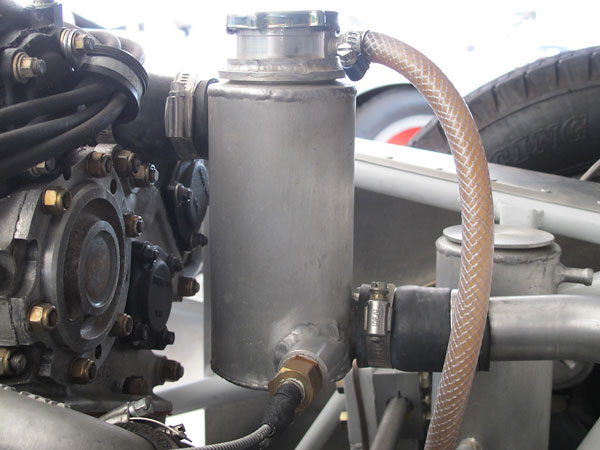
�
Custom fabricated coolant header tank / swirl pot.
�
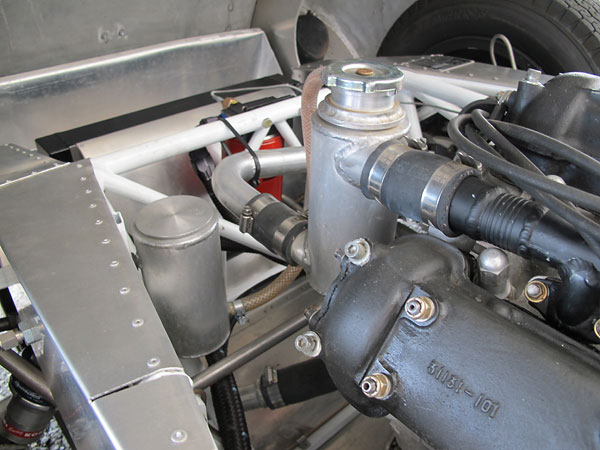
�
If coolant pressure rises too high, the system will vent into the overflow tank at left.
�
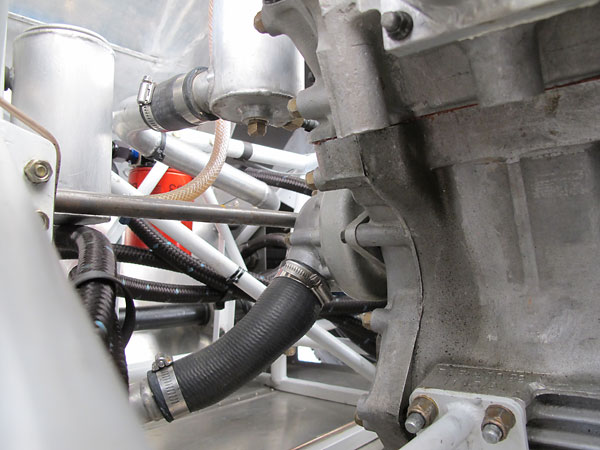
�
Water pump and lower radiator hose.
�
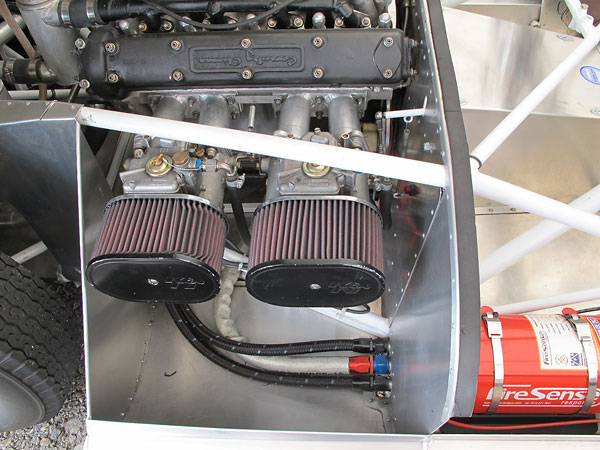
�
K&N pleated oiled-gauze air filters. Hoses to and from a rear-mounted engine oil reservoir.
�
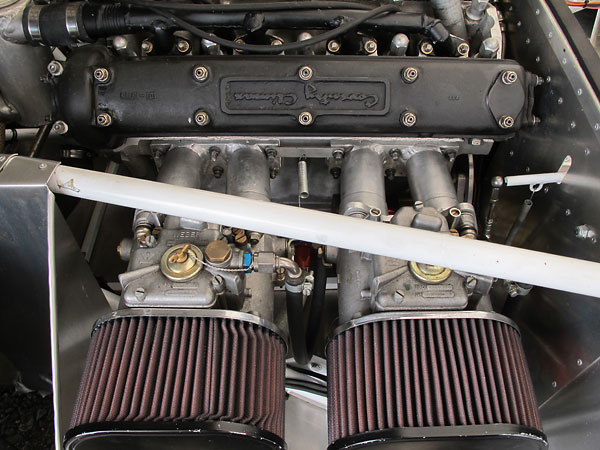
�
Dual Weber carburetors mounted on custom fabricated aluminum intake manifolds.
�
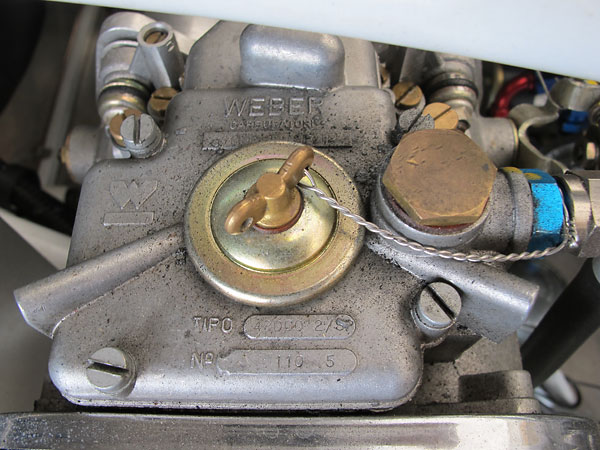
�
Weber Type 48DCO 2S/P carburetor, number 110 5.
�
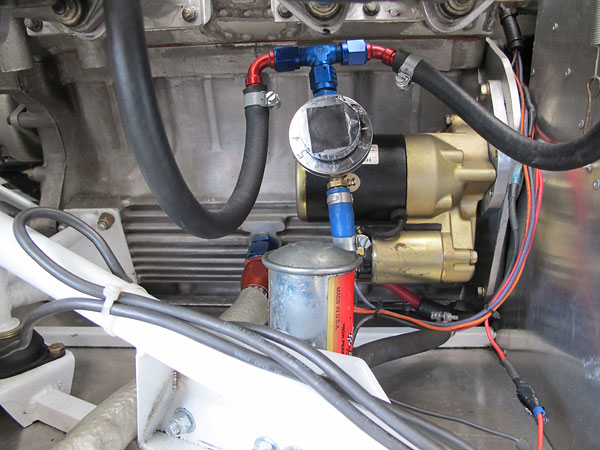
�
Facet (Bendix Style) electric fuel pump and Mr Gasket adjustable (1-6psi) fuel pressure regulator.
�
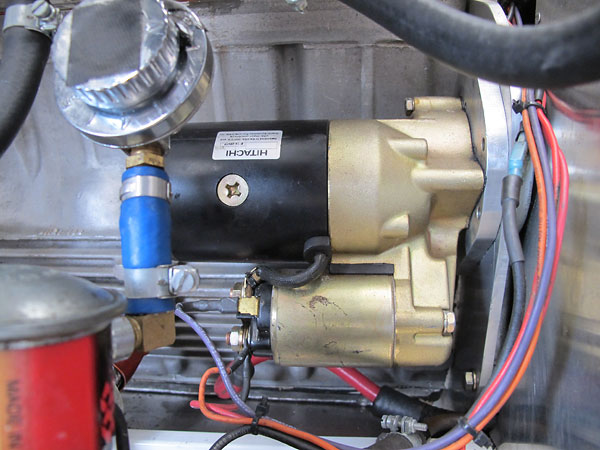
�
Hitachi gear reduction starter, part number B114-264TP. Note aluminum adapter.
�
Back in the day, a large Lucas starter was used.
�
�
Front Suspension / Etc.
��
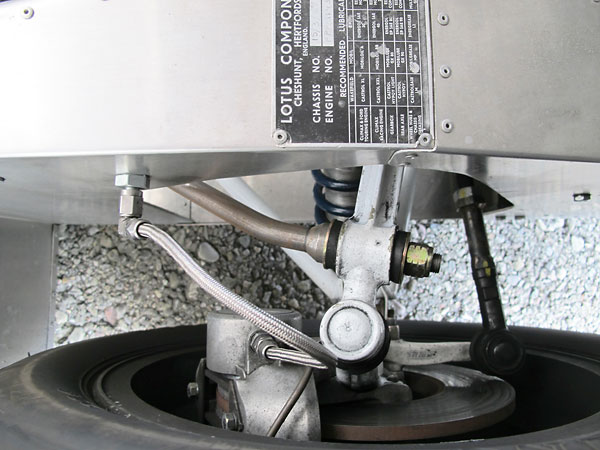
�
Lotus initially utilized the Eleven Series 2 front suspension on the Lotus 15. Nominally this was
�
a dual wishbone front suspension. However, to minimize weight Lotus configured anti-sway bar arms
�
to also serve as the forward facing legs of the upper control arms. As shown here, for the Lotus 15
�
Series 3 Lotus simply flipped that idea around so that the anti-sway bar were mounted on the
�
rearward side. This change was reportedly made to provide more room for radiator installation.
�

�
Alford & Alder forged uprights. KONI double-adjustable aluminum body coilover shock absorbers.
�
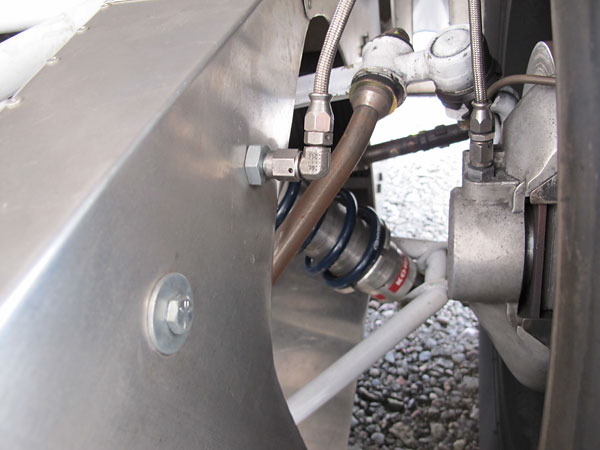
�
Using an anti-sway bar as a suspension link is inherently problematic. The bar inevitably flexes
�
and binds, causing odd suspension behaviors which can be difficult to diagnose or correct. This
�
Lotus 15 Series 3 was originally built with a 1/2" diameter front anti-sway bar. Handling
�
improved dramatically when it was upgraded to a 5/8" diameter bar.
�
Altered roll stiffness was only part of the result.
�

�
Girling AR 2" bore aluminum brake calipers with 9.5" solid rotors, mounted outboard.
�

�
Steering rack mounting details. Note also that lower control arm mounting points are widely spaced
�
to better absorb braking reaction forces.
�
�
Enjoying this article? www.BritishRaceCar.com is partially funded through generous support from readers like you!
�
To contribute to our operating budget, please click here and follow the instructions.
�
(Suggested contribution is twenty bucks per year. Feel free to give more!)�
Rear Suspension
��

�
The Lotus 15's Chapman Strut independent rear suspension is remarkably simple and lightweight. In
�
principle, the strut is simply a coilover shock absorber with its bottom end rigidly connected to
�
the hub carrier. It's the associated lower link which distinguishes a Chapman Strut: there's no
�
lower control arm and instead a fixed length halfshaft determines the suspension's track width.
�
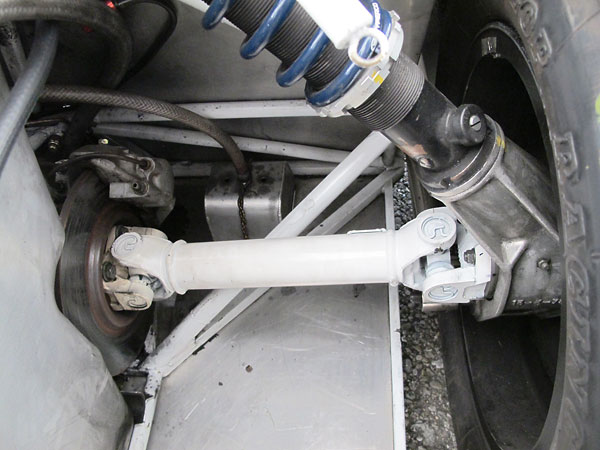
�
On bump or roll, as the coil spring and shock absorber compress, the top of the tire tends to angle
�
inward producing a camber gain effect. Chapman promoted this as stability enhancing, and additionally
�
noted that it automatically compensates for the changing traction available due to reduction in fuel
�
weight over a long race. Although this design was generally carried over from the Lotus 12 F2
�
car, one detail difference is that the shocks are angled more inward for greater camber gain.
�

�
Girling NR 1.5" bore aluminum brake calipers with solid rotors, mounted inboard to
�
minimize unsprung weight and thereby improve road holding and ride quality.
�
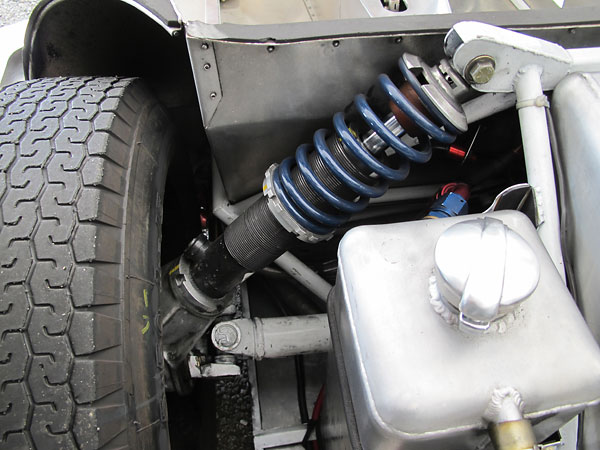
�
Unfortunately, our photos don't show the single dog-legged trailing link (a.k.a. radius rod) which
�
connects very low on the hub carrier and routes forward and inboard parallel-to but a couple inches
�
above the floorboard to control fore/aft wheel movement. It's a rather short trailing link, so its
�
rotational movement causes significant toe-in on bump and thus a noticeable roll understeer effect.
�
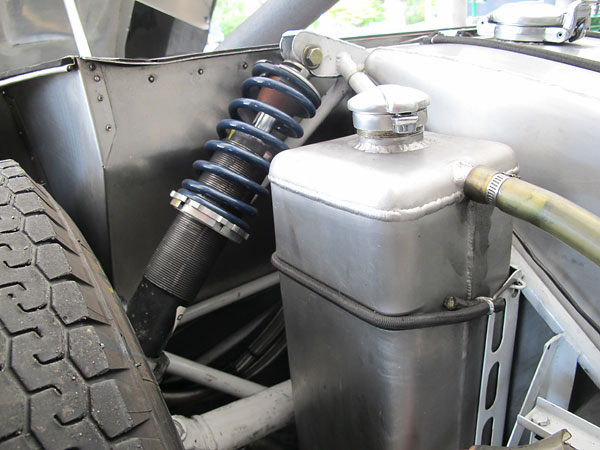
�
Colin Chapman advocated use of soft spring rates in combination with relatively firm shock absorber
�
valving. The original shocks were made by Armstrong, and they didn't have threaded perches for easy
�
ride height adjustment. These are newer and far more sophisticated KONI double-adjustable shocks,
�
with Silasto bump rubbers which have been engineered to provide a rising-rate through their range
�
of compression. Foreground: custom aluminum engine oil reservoir. On cars equipped with Lotus'
�
Queer Box transmission, a gearbox oil reservoir would also be mounted in this space.
�
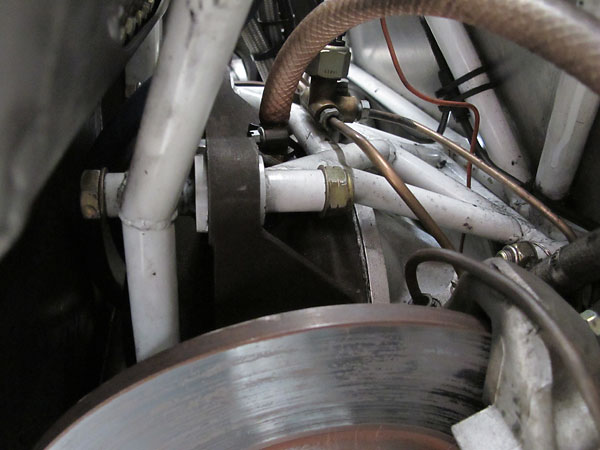
�
A BMC-pattern differential and gear set are housed inside this light alloy housing. This design
�
was available off-the-shelf; it had previously been developed for the Lotus Elite sports car.
�
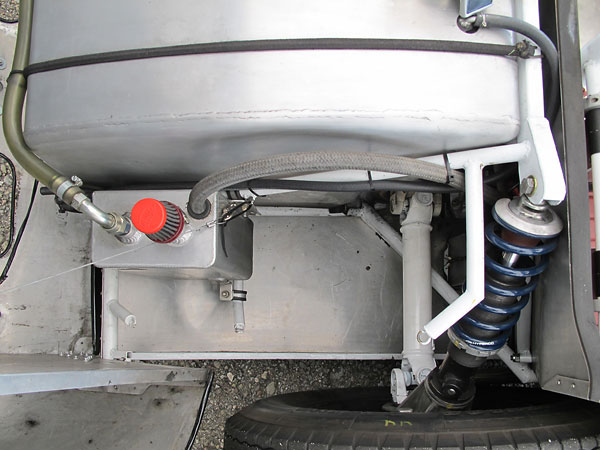
�
Le Mans rules have traditionally required that racers carry spare tires. On the 15, Lotus
�
placed the spare tire upright and projecting into the headrest fairing. Here you can see
�
the three tubular support brackets Lotus provided for the spare tire.
�
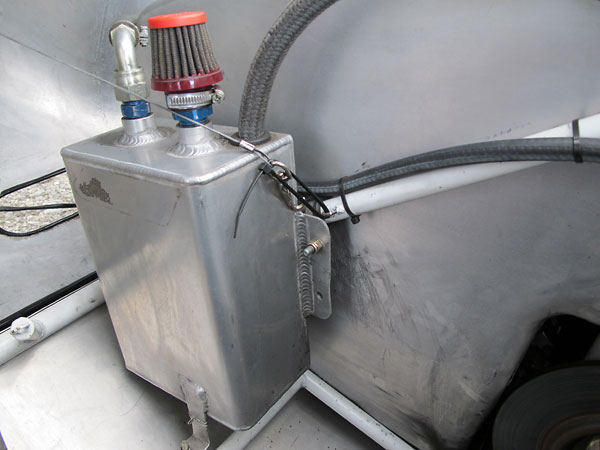
�
This custom fabricated aluminum overflow/breather tank is a modern addition.
�
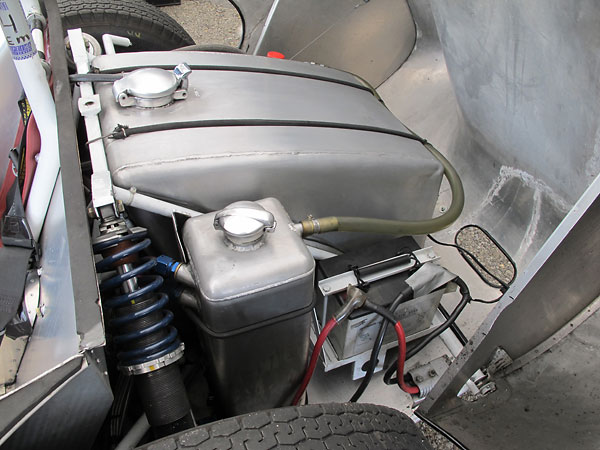
�
Enersys Genesis (Yuasa) NP33-12 sealed lead acid battery.
�
�
Interior
��
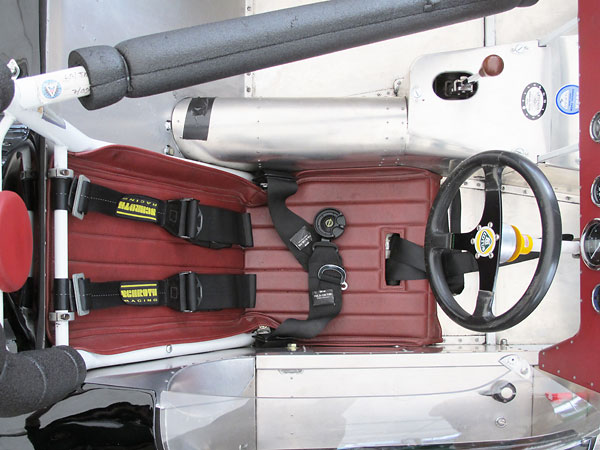
�
Very thin seat cushions are part of a strategy of placing the driver as low as possible.
�
The shoulder straps of this Schroth Racing 6-point cam-lock safety harness are narrow for
�
compatibility with new head and neck support (HANS) devices.
�
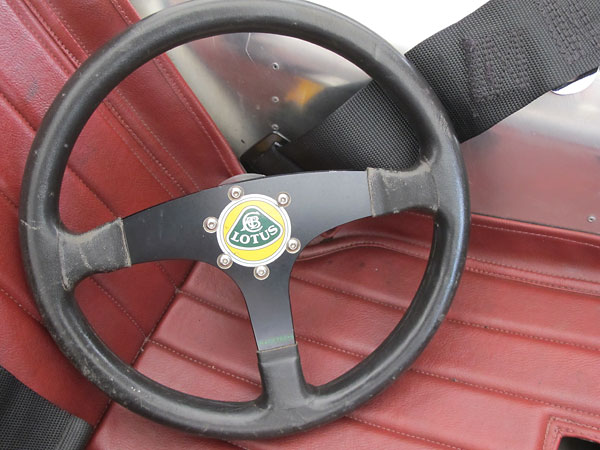
�
RaceTech leather wrapped aluminum steering wheel.
�

�
SPA quick release steering wheel hub.
�
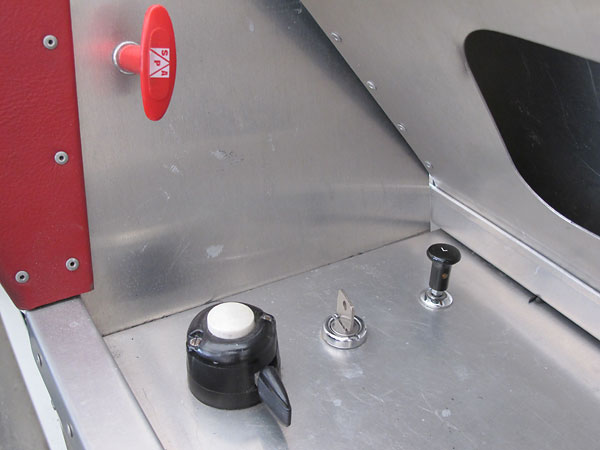
�
Horn and dip switch? (Is that what it's used for now?)
�
Does the key switch control the starter too?
�
What is the knob at right for? (Lights?)
�
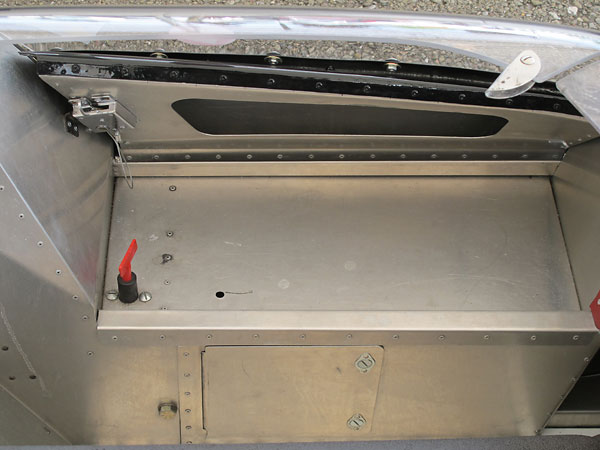
�
What's behind this access panel? (Plumbing to the dry sump? What else?)
�

�
This Lotus 15 originally came with an MGA four speed, but that gearbox failed while original owner
�
JC Kilburn was racing at Nassau in December 1959. Evidently looking for a more robust alternative,
�
Kilburn had a Borg Warner T10 four speed installed. A Hurst shifter mounts to its lefthand side.
�
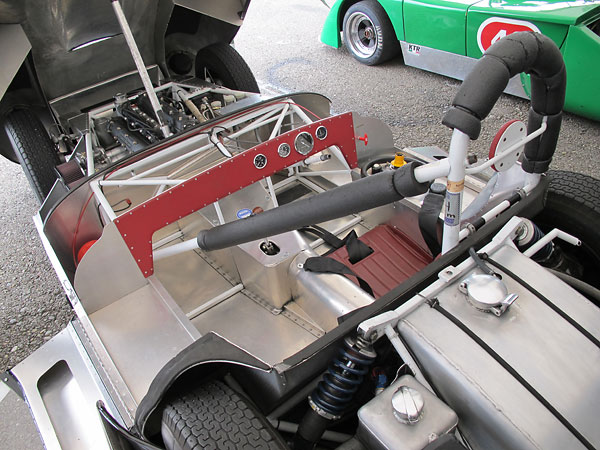
�
If this particular Lotus 15 had a Queer Box five-speed, the shifter mechanism would look different.
�
The main shifter moved fore and aft. From neutral, the driver would pull the lever rearward to
�
engage first (for starting from a stop only.) To upshift, he'd snap the lever forward repeatedly,
�
once for neutral, twice for second, etc., up to fifth. Reverse had its own lever, projecting
�
from the back wall between the seats, and operated by the driver's left elbow.
�
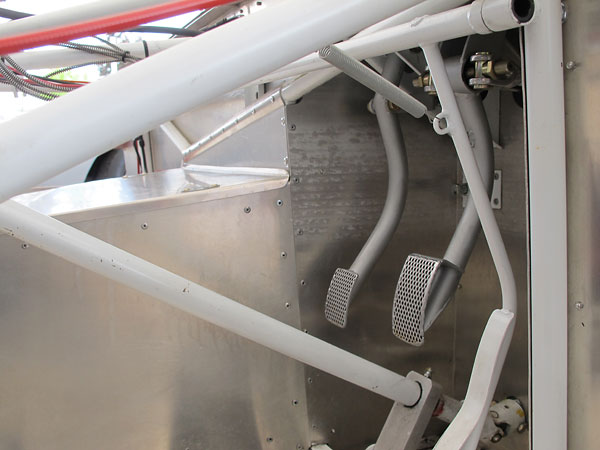
�
The earliest Lotus 15s had single circuit brake plumbing, and no means for adjusting front to rear
�
brake bias. By introduction of the Lotus 15 Series 2, dual master cylinders were a standard feature.
�
Here, you can see the threaded rod that distributes pedal force between the two master cylinders.
�

�
Instead of a cable, the Lotus 15 features a nice, simple, and robust mechanical throttle linkage.
�

�
Series 3 cars have one piece front clips which extend all the way from the grille back to the dashboard.
�
Series 1 and 2 Lotus 15s have a shorter front clip and a separate, fixed cowl similar to Lotus Elevens.
�
The two tubes that drop from the dashboard straight down to the floor and the transverse tubes they
�
meet there are also distinctive features of the Series 3 model.
�

�
Lotus 15 frames were constructed from a selection of 18 and 20 gauge steel tubing. The main tube
�
size used was 1.75" diameter round. Square section steel tubing was used in some places too.
�
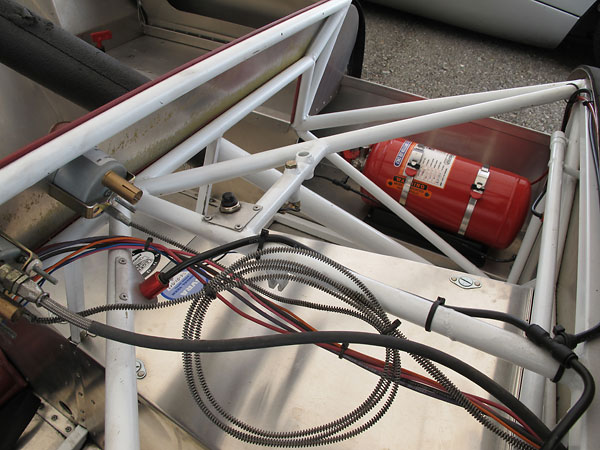
�
This pushbutton switch actuates features of the Stack electronic tattle-tale tachometer.
�
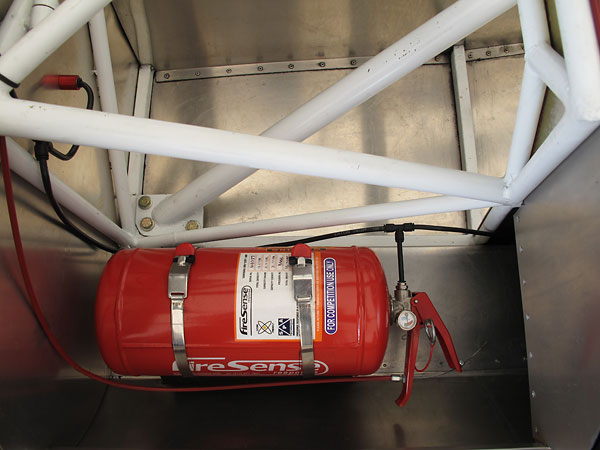
�
SPA Firesense AFFF (15 pound, 2 liter) centralized fire suppression system.
�

�
The standard equipment 19 Imperial gallon fuel cell seems huge, but the Lotus 15 was largely designed
�
for endurance racing. For those events, typically a four or five gallon tank would be added where the
�
FireBottle is now. Additionally, a saddle tank would have been added behind the dashboard for Le Mans.
�
�
Exterior
��

�
We enjoyed watching Dudley race his Lotus 15 at the 2011 U.S. Vintage Grand Prix of Watkins Glen,
�
where his best lap was 2:16.713, for an average of 89.5mph over the challenging 3.4 mile circuit. He
�
won SVRA's Group 3 / Group 4A feature races by comfortable margins on both Saturday and Sunday.
�

�
John Brundage congratulates Dudley Cunningham on another fine victory.
�
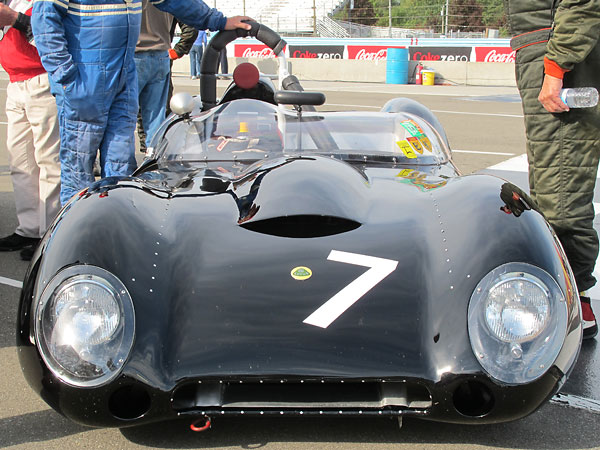
�
Whereas the design of the Lotus Eleven body is always credited to Frank Costin, the Lotus 15 body isn't
�
usually credited to a specific designer. It's clearly a derivative of its more famous predecessor, and
�
Frank Costin did apply for a patent on the "high tail" body feature. Other details may have been
�
sketched by Lotus head Colin Chapman himself. In any event, construction was entrusted to
�
one of the preeminent coach builders of the day: Williams and Pritchard Ltd.
�
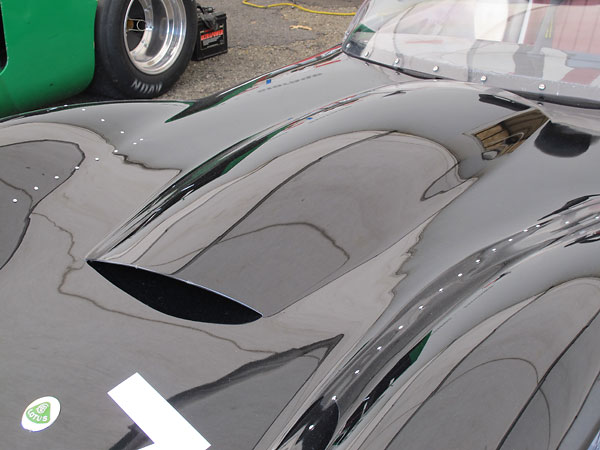
�
The Lotus 15 proved attractive for engine swaps. Jean Pierre Kunstle of California installed a 2.0L
�
Ferrari four cylinder, and raced as early as 7 June 1959. Gene Bosman of Pretoria, South Africa
�
installed a bored-and-stroked (1.5L) Alfa four cylinder in October 1960, and raced successfully.
�
Dizzy Addicott's Buick 215 aluminum V8 powered car achieved excellent results in England
�
through the 1962 racing season. It's recently been restored with classic Buick engine in situ!
�
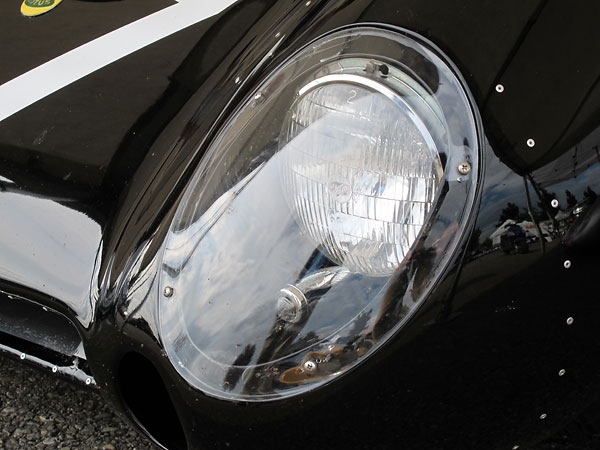
�
Some race fans see sports racers, and can't help but wonder "What if?" Several Lotus 15s have been
�
registered and used as street cars - including this one - after it was fitted with a Buick 215 V8 in or
�
around 1962. In this form, it made frequent appearances at car shows in the Upper Midwest.
�
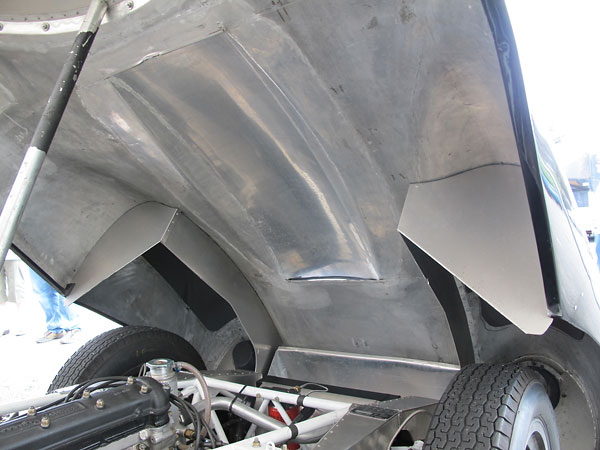
�
Riveted-on splash guards are part of the original Lotus 15 design. On some cars the rivet heads
�
have been painted over, but if it's original bodywork it will certainly have rivets.
�
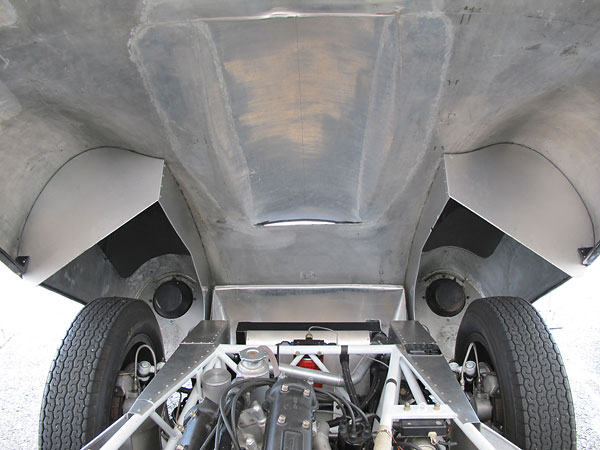
�
After the earliest cars were built, Lotus decided to shift the FPF more upright in the Lotus 15 chassis.
�
At that time, a hood scoop was added to accommodate the taller engine installation.
�
Later Series 3 cars have the scoop opening toward both the front and the rear.
�

�
Operable doors were required by Le Mans rules. Be extra careful stepping over these: their
�
wrap-around Perspex windscreens make them especially vulnerable to damage in the paddock.
�
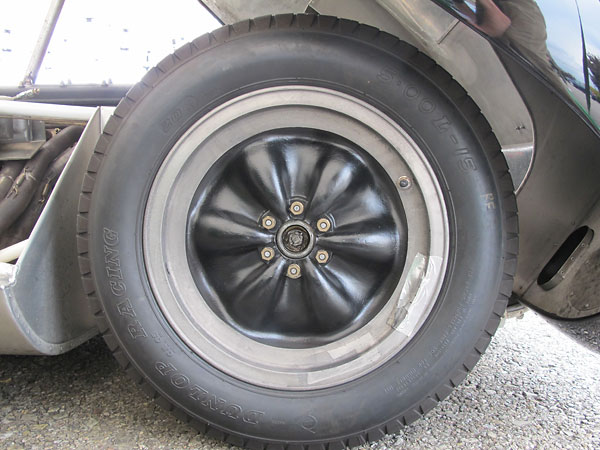
�
Lotus magnesium wobbly-web 6-lug wheels were standard equipment on the Lotus 15, but probably
�
better than half of the cars produced were equipped with spoke wheels because (a) they were
�
less expensive and (b) they could be changed quickly during an endurance race. However,
�
the magnesium wheels were significantly lighter weight.
�

�
Dunlop Racing tires (5.00L-15 front & 5.50L-15 rear, CR65 MkII tread pattern, 204 compound.)
�
�
All photo shown here are from September 2011 when the car appeared at The US Vintage Grand Prix at Watkins Glen.�
Photos by Curtis Jacobson for BritishRaceCar.com. Copyright 2012. All rights reserved.
�
| If you liked this article, you'll probably also enjoy these: | �|||||
 | �
Jeff Snook '56 Lotus XI LeMans | �
 | �
Jay Nadelson '57 Cooper T43 | �
 | �
Tom Grudovich '60 Lola Mk1 | �
| You're invited to discuss anything you've seen here on The British Racecar Motorsports Forum! | �|||||
�
Notice: all the articles and almost all the photos on BritishRacecar.com are by Curtis Jacobson.
�
(Photos that aren't by Curtis are explicitly credited.) Reproduction without prior written permission is prohibited.
�
Contact us to purchase images or reproduction permission. Higher resolution images are optionally available.
�

 �
�